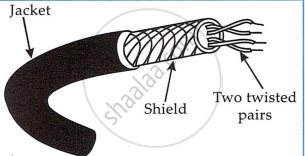Topics
Introduction to Microprocessors and Organization of 8085
Instruction Set and Programming of 8085
Introdcution to Inted X-86 Family
Introduction to Microcontroller
Networking Technology
- Introduction to Networking
- Types of Networks
- Multiplexing
- Study of Transmission media
- Coaxial cable (Cable Media)
- Twisted pair cable
- Fiber Optic Cable
- Unbounded (Wireless) Media
- Access Methods
- Network Topologies
- Ethernet (Network Architectures)
- Token-Ring (Network Architectures)
- Internet protocols
- Introduction to connectivity devices
- Construction
- Advantages and Disadvantages in Coaxial Cable.
Twisted pair cable
This is a popular cable for all new networks. This is a low cost cable. A basic twisted pair cable is shown in figure.

Twisted pair cable consists of two copper wires twisted together, reducing sensitivity to EMI and minimizing radio frequency noise. This design cancels out radiated signals and reduces crosstalk, improving overall signal integrity.
Construction
Shielded twisted pair (STP) cable: Shielded twisted pair (STP) cable includes one or more twisted pairs enclosed in foil and woven copper shielding. The shield, connected to the device's ground, prevents signal interference. STP cables come in various types for different applications.

Unshielded Twisted-Pair (UTP) cable: Unshielded twisted pair (UTP) cable lacks a braided shield, differing from STP primarily in attenuation and EMI resistance. Commonly used in telephone systems and increasingly in LANs, UTP cable is available in five categories for various applications.
Advantages and Disadvantages of Coaxial Cable.
Advantages:
- This medium is inexpensive and easy to install.
- Since wires are twisted, it reduces EMI and avoids RF radiation.
- Twisted wires also reduce cross talk.
Disadvantages:
- They can be used only for· short distance communications.
- The twisted pair cable has limited bandwidth for audio telephone it is 4 KHz and it can be maximum 50 KHz.
- The typical speed of computer date is 1200 bits/ second (bps)
